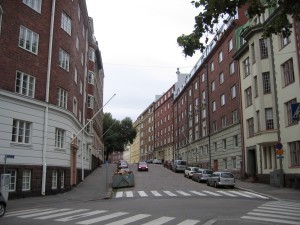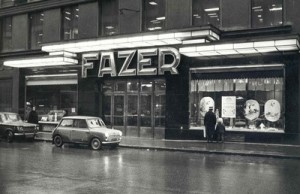Helena Halme's Blog, page 20
June 6, 2016
It’s Time for the Crouch End Festival!
 It’s here again! The Crouch End Festival, UK’s largest community arts event, is now in its fifth year, and this, the 2016 festival will be bigger than ever.
It’s here again! The Crouch End Festival, UK’s largest community arts event, is now in its fifth year, and this, the 2016 festival will be bigger than ever.
There’s everything from open air cinema, live music, art, poetry, food and even a Latino Day when Crouch End goes all Latin. Check out the programme of events between 10 – 19th June on the festival website here. Most of the events are FREE, so it’s worthwhile making a trip to North London next week!
You may not be surprised that I’m organising a few literary events for the festival. Here are my highlights:
Desert Island Books 14th & 17th June
 Each evening of 14th and 17th June, four authors share their Desert Island Book choices at Harris + Hoole coffee house. Both evenings start at 6.30pm.
Each evening of 14th and 17th June, four authors share their Desert Island Book choices at Harris + Hoole coffee house. Both evenings start at 6.30pm.
Imagine that due to unseasonal flooding, all of London is under water, apart from a small area around the Crouch End Clock Tower. You may have to suspend your disbelief a little …
On the 14th June, I’m joined by queen of domestic thrillers, Louise Millar, author of gritty and fast-paced London Detective Belsey series, Oliver Harris, and TV Doctor and author of contemporary fiction Carol Cooper. The authors will talk about which books they’d like to have on a Crouch End desert island, and read from their latest work.
On the 17th June, ‘Great comedy talent’, Dominic Frisby, hosts the second instalment of Desert Island Books with Ann Richardson, non-fiction author of true stories, Yana Stajno, artist and author of comic romance, Lucy Branch, author of magical realism thrillers, and Clare Lydon, writer of contemporary lesbian romance.
Joan Ellis One Woman Show 16th June
 On 16th June, Crouch End Festival sees the return of the fabulous Crouch End local, Joan Ellis. Award-winning advertising copywriter, comedy writer, performer, lecturer – Joan Ellis has been them all. Now an acclaimed author, Joan is performing her new show, written for any woman: ‘A Woman’s Wit, Wisdom and Pratfalls’ showcasing our funny bones and our flaws.
On 16th June, Crouch End Festival sees the return of the fabulous Crouch End local, Joan Ellis. Award-winning advertising copywriter, comedy writer, performer, lecturer – Joan Ellis has been them all. Now an acclaimed author, Joan is performing her new show, written for any woman: ‘A Woman’s Wit, Wisdom and Pratfalls’ showcasing our funny bones and our flaws.
Meet the flip, fearful, fantastic women from her four, 5* books: chick lit, memoir and psychological thrillers including the acclaimed chiller, ‘The Killing of Mummy’s Boy’, inspired by Joan’s real life encounter with a murderer on a train. Having survived, his twisted insights into a criminal mind were too good to waste.
Joan also takes a wry view of a woman’s lot, including the perils of working with animals, children and celebrities in 80s Adland, (think Mad Men meet Bridget Jones) and bringing up baby, alone, juggling a fulltime job, running a comedy club and larging it, in a very small way, in Crouch End. Join Joan Ellis at 7.30 pm in Harris+Hoole.
So You Want to Be a Writer?
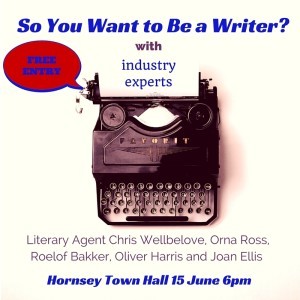 On Wednesday 15th June at 6 pm, author and publisher Roelof Bakker of Negative Press, founder and Director of the Alliance of Independent Authors Orna Ross, author Oliver Harris, adwoman & performer Joan Ellis and literary agent Chris Wellbelove discuss what it takes to write a book, and how to get published.
On Wednesday 15th June at 6 pm, author and publisher Roelof Bakker of Negative Press, founder and Director of the Alliance of Independent Authors Orna Ross, author Oliver Harris, adwoman & performer Joan Ellis and literary agent Chris Wellbelove discuss what it takes to write a book, and how to get published.
There will be a Q&A session at the end, so have your questions ready!
The venue for this event is the Council Chamber on the 1st floor of the magnificent Hornsey Town Hall.
All events are free, but to avoid disappointment, please register for So You Want to be a Writer? event here.
Don’t miss these fantastic free Crouch End Festival events!
The post It’s Time for the Crouch End Festival! appeared first on Helena Halme.
June 2, 2016
Advice for New Writers Part 7: Do I Need an Author Platform?
 Whether you are a traditionally published author, an indie or something in between, the commonly accepted wisdom is that you need an author platform. But why?
Whether you are a traditionally published author, an indie or something in between, the commonly accepted wisdom is that you need an author platform. But why?
Why do you need to broadcast to the world about your writing? Why do you constantly need to post on Facebook, Twitter, Pinterest, Instagram, Goodreads, or whatever? Isn’t it quite enough that you write a good book? Won’t readers just flock to read your books once they’re published?
If only.
Writing an excellent book is sadly not enough, unless you are very, very lucky. (Think lottery winner). That excellent book is merely your entry to the market. If you don’t do anything else but publish the novel with a good cover, and blurb, it may still never sell in any significant numbers. Why?
Because there are millions of books published on Kindle alone, some of them are good, some very good, some excellent (and sadly some not so good). There is incredible competition out there and bookshops such as Amazon, Kobo or iBooks will only push titles that have good sales records. So you as an author will need to build your own fanbase, know what your readers are like, and be able to reach out to them when your book is out.
Think of yourself as a small business. If you produce a hand-crafted cabinet but don’t tell anyone about it; how it was made; why it is a better cabinet than all the other cabinets on the marketplace, no-one will ever see your brilliantly built cabinet, let alone buy it.
In order to sell your brilliantly written book, you need to learn to market it. The first step in that marketing is building an author platform.
This all sounds scary, but it needn’t be. Starting small is the key. Even if you are only just planning to write your first novel, it’s more than worthwhile to begin the process of building your author platform, because when your book does come out, you will already have a fanbase, which you can rely on to buy your book, review it and in that way make it more visible in online shops such as Amazon.
First step is to set up a webpage, through which you can collect an email list of your fans. But more about the practicalities on how to build an author platform in part 8 of Advice for New Writers, which will be up here on my blog next week.
In summary, it’s vital to build an author platform, because it will allow you to build a growing fanbase which in turn will sell your books. Because we all need to eat, right?
The post Advice for New Writers Part 7: Do I Need an Author Platform? appeared first on Helena Halme.
May 27, 2016
The Finnish Girl out in paperback soon!
 My first Kindle. Aaah…
My first Kindle. Aaah…One of the best jobs I ever had was to be a bookseller. The year that I spent in the now sadly closed England’s Lane Books in Northwest London, could easily be described as the happiest of my life. I would go as far to say that it was also a life-changing time for me, because two momentous events happened that same year: we moved from a longtime family home in the country to London, and I published my first novel, The Englishman.
But I was also an early adopter of e-books. I bought a Kindle as soon they came out and that first novel was initially published as an e-book. However, I never lost my love for physical books. The ability to touch a book, to lend it to a friend, and the smell (right?), are all unbeatable characteristics of physical books.
Nowadays I would say I read 50/50 ebooks and physical books. Sometimes I buy a title in both versions; it’s so much easier to travel with a Kindle than it is with a heavy book.
But because I love physical books so much, each time one of my own books comes out in paperback, I feel that it is the REAL launch of the title!
So I’m thrilled to let you know that my latest book, The Englishman prequel novella, The Finnish Girl will be out in paperback on 6th June! (I will do a little dance around the kitchen to Abba’s ‘Dancing Girl’ on the day.)
And if that wasn’t enough, you can also win a FREE copy of the book!
From Monday 30th May you can enter to win a signed copy of The Finnish Girl in paperback on a Goodreads Giveaway. Details are below (you may have to sign in to enter).
Good luck!
Goodreads Book Giveaway
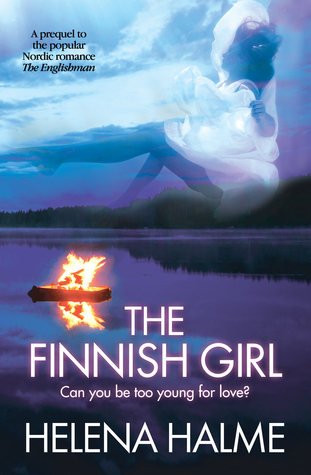
The Finnish Girl
by Helena Halme
Being released June 06 2016
This giveaway has not started.
Starts in 5 days.giveaway details »
The post The Finnish Girl out in paperback soon! appeared first on Helena Halme.
May 18, 2016
Memories of the London Book Fair
It’s a month or so since the hustle and bustle of The London Book Fair, and I have just about recovered. As usual it was a very busy time for me, catching up with fellow ALLi indie authors, attending seminars, meeting new and interesting fellow book people (most memorably sharing a sandwich with a new friend, David P Perlmutter), and meeting up with some of the Finnish literary contingency, such as the folks at FILI and Stilton Literary Agency.
 Happy ALLi writers Orna Ross, Rohan Quine, Marisha Pink , Jessica Bell and me.
Happy ALLi writers Orna Ross, Rohan Quine, Marisha Pink , Jessica Bell and me.There were drinks dos, parties sponsored by Amazon (I know, right?), and a lot of selfies …
 The ‘literary sisters’ Karen Inglis, Carol Cooper & me.
The ‘literary sisters’ Karen Inglis, Carol Cooper & me.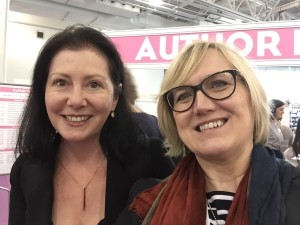 Me with crime author from Triskele Books, J J Marsh
Me with crime author from Triskele Books, J J MarshTowards the end of the LBF week I was interviewed by Kobo, the online book retailer. I’m joined in this clip by brilliant indie authors, Clare Flynn, Chele Cook, Eliza Green, Karen Inglis, Rohan Quine, Clare Lydon and Margaret Skea.
I’m already looking forward to LBF 2017. If you can’t wait that long, or missed the action in London, you can join the Indie Author Fringe events online, which cover The London Book Fair, Book Expo America and The Frankfurt Book Fair. Sign up here and get access to blogs, podcasts, video tutorials, interviews, competitions and much more.
The post Memories of the London Book Fair appeared first on Helena Halme.
May 17, 2016
Book Review: The House of Fame by Oliver Harris
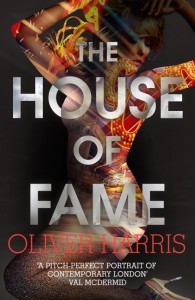 I’ve loved the North London police dramas written by Oliver Harris for a while, mainly because they are well-written, fast-paced, and star a hard-nosed, but fair-minded and gentle-hearted police detective, Nick Belsey. This third instalment in the Belsey crime thriller series sees our police detective hiding out in a boarded up Hampstead Police Station. He has been suspended, and is lying low with an internal investigation hanging over his head.
I’ve loved the North London police dramas written by Oliver Harris for a while, mainly because they are well-written, fast-paced, and star a hard-nosed, but fair-minded and gentle-hearted police detective, Nick Belsey. This third instalment in the Belsey crime thriller series sees our police detective hiding out in a boarded up Hampstead Police Station. He has been suspended, and is lying low with an internal investigation hanging over his head.
Belsey’s down and out lifestyle is temporarily elevated when, following a plea from an elderly lady to find her missing son, he gets embroiled in the life of a famous singer and celebrity Amber Knight. Belsey’s situation soon worsens when a body of another young socialite is found in Mayfair, very close to a club where the ex-policeman spends a night out with Amber.
While the body count increases, and Belsey has a possible murder charge hanging over his head, adding to his already long list of misdemeanours with the Metropolitan police force, he doggedly continues his investigations. Soon he discovers a suspicious international organisation, promising a better life to its members. As he delves deeper into the strange goings on, his own life is under threat from a much more familiar direction.
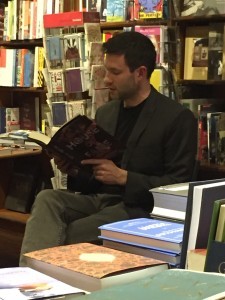 Oliver Harris reading from The House of Fame at West End Lane Books in London
Oliver Harris reading from The House of Fame at West End Lane Books in LondonIf you want a thriller you cannot resist picking up when you should be doing something else (like writing your own novel, ahem), this is the book for you. A bonus for those who love crime thrillers set in London is the authenticity of the settings. I know many of the backstreets and alleyways Belsey visits, and they’re spot on. (What that says about me is another matter …)
The House of Fame by Oliver Harris
Hardcover £9.74 / Kindle £9.99
*****NEWSFLASH*****
Oliver Harris will be talking about The House of Fame at The Crouch End Festival during Desert Island Books Choice on 14th June 2016. He will talk more generally about what it takes to be a successful author as part of an expert panel of an event called, So You Want to Be a Writer, on 15th June.
Both events are free to attend!
More details on the Crouch End Festival and both of the above events, click here.
The post Book Review: The House of Fame by Oliver Harris appeared first on Helena Halme.
May 16, 2016
My Romantic Helsinki
All of my Nordic romance novels are partly set in Helsinki, so I thought I’d take you on a pictorial tour of the city, as featured in The Englishman series of books.
 One of the shores of ‘Laru’.
One of the shores of ‘Laru’.In my latest title The Finnish Girl, Kaisa is 14 when she moves with her sister Sirkka and her mother Pirjo to one of the island suburbs of Helsinki, called Lauttasaari. Pirjo rents a small flat in ‘Laru’ as the area is fondly referred to by those living there.
Lauttasaari is a 20 minute bus ride from the centre of Helsinki, and the Swedish School of Economics, Hanken, where Kaisa later is enrolled as a student. In the first novel in the series, The Englishman, Kaisa envies her new friend, Tuuli, who lives just a walking distance from the university in Töölö. She ends up spending many nights sleeping over in Tuuli’s flat, because she misses the last bus to Lauttasaari.
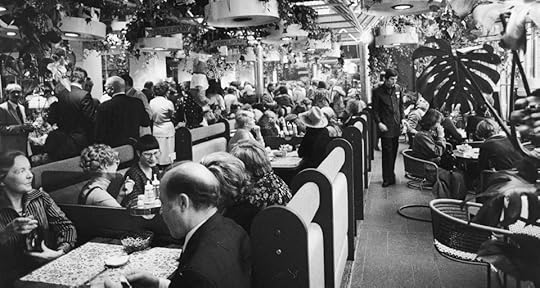 The Happy Days Cafe is also featured in my Cold War spy thriller, The Red King of Helsinki.
The Happy Days Cafe is also featured in my Cold War spy thriller, The Red King of Helsinki.A place where I particularly love to set my 1980’s Helsinki scenes is the Happy Days Cafe on North Esplanade. When it opened in 1979, it was one of the new fashionable cafe restaurants, where you could have an alcoholic drink without ordering food. This, believe me, was revolutionary in Finland in those days. The Happy Days Cafe still exists but is now called Baariteatteri (The Bar Theatre).
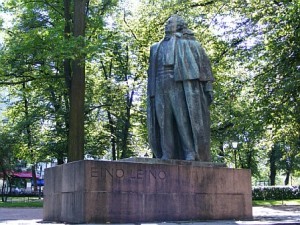
From the Happy Days it’s only a short walk to the statue of the Finnish national poet Eino Leino, where a very romantic and pivotal scene takes place in The Englishman. It’s where Kaisa and Peter share their first proper kiss and promise to see each other again.
Another cafe which Kaisa visits in the series of books, is the Fazer Cafe on Kluuvikatu. This, a much more expensive and traditional restaurant cafe, opened in 1891 and is also featured in the fourth book in the series, which I am currently writing. (Title reveal coming up very soon, sign up to my Newsletter to be the first one to find out what it will be called!). The street was pedestrianised in the 1990s, but when Kaisa was in Helsinki in the 1980s it looked very much like the black and white picture here.

Stockmann’s department store is another place, which I use a lot in my novels. Kaisa has a rendezvous with The Englishman under the Stockmann’s clock, which is a popular meeting point in Helsinki. Kaisa also worked there in The Englishman, and the store is featured in all of my books.
 A place where Kaisa sheds many tears as she says goodbye to her beloved Englishman is the Helsinki International Airport at Vantaa. Even now when I arrive there, I have a lump in my throat when I think back to all those desperate farewells we shared there with my Englishman. But I couldn’t talk about leaving Helsinki without mentioning the most romantic place in the city – the Helsinki central railway station. I love the style of the building and the fact that it’s a working station, which is being constantly improved and restored.
A place where Kaisa sheds many tears as she says goodbye to her beloved Englishman is the Helsinki International Airport at Vantaa. Even now when I arrive there, I have a lump in my throat when I think back to all those desperate farewells we shared there with my Englishman. But I couldn’t talk about leaving Helsinki without mentioning the most romantic place in the city – the Helsinki central railway station. I love the style of the building and the fact that it’s a working station, which is being constantly improved and restored.
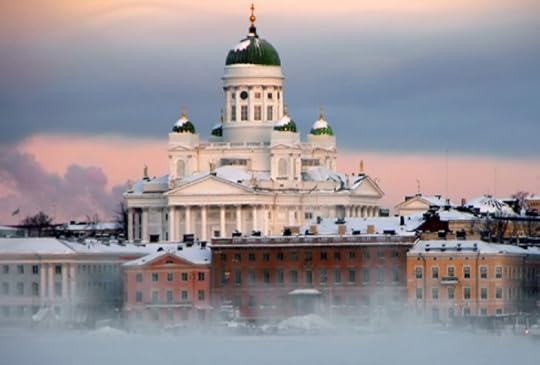 Helsinki Cathedral. Photo: Visit Helsinki/Niclas Sjöblom
Helsinki Cathedral. Photo: Visit Helsinki/Niclas SjöblomFinally, I have to share a picture by Visit Finland/Niclas Sjöblom of the Helsinki Cathedral. Each time I visit the city, I take a few snaps but nothing like this one. The cathedral dominates the centre of Helsinki and here you can see it rising above a wintry mist in the South Harbour. Beautiful, isn’t it?
The post My Romantic Helsinki appeared first on Helena Halme.
April 28, 2016
5 Tips for Writing Historical Fiction by Clare Flynn
 Cla
Cla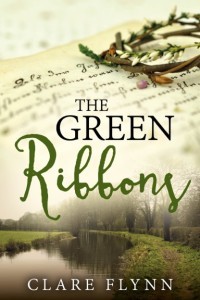 re Flynn is the author of A Greater World, Kurinji Flowers and Letters from a Patchwork Quilt. Clare’s latest novel, The Green Ribbons, which is set in England in 1900 will be published in May 2016. But as luck would have it, today you can pre-order a copy of the new novel. (Tap here to order your copy.)
re Flynn is the author of A Greater World, Kurinji Flowers and Letters from a Patchwork Quilt. Clare’s latest novel, The Green Ribbons, which is set in England in 1900 will be published in May 2016. But as luck would have it, today you can pre-order a copy of the new novel. (Tap here to order your copy.)As the author of 4 historical novels, I’m delighted that Clare agreed to offer her insights into writing historically accurate, whilst still engaging, stories set in the past. Her 5 tips are elementary for any author who wishes to write historical fiction, and I am exceptionally grateful to this hugely knowledgable and talented lady!
1. Do the research but wear it lightly
There are two big watch-outs for the writer of historical fiction and they are two sides of the same coin.
Some writers believe that, because they are writing fiction, that absolves them of the need to be thorough in the detail that underpins their story. “It’s fiction, after all.” Yes, but it’s also historical! Getting the facts wrong immediately signals that the writer is not in control of their subject and this undermines authorial credibility. Readers of historical fiction are often extremely knowledgeable about history. Failure to properly research your time period can raise hackles. I’m not talking about interpretation here – Hilary Mantel’s Cromwell good vs More bad is absolutely fine, whether you agree with her or not, because she has done the research and then made a considered interpretation. No, I’m talking about getting the facts wrong or twisting them to fit the story. Hollywood movies have a terrible tendency to do this and it drives me crazy – the Americans did not capture the Enigma machine – it happened before they even entered the war. Even those who write Alternative History need to work hard and do the research to make their departure from actual events plausible to the reader.
The other side of the coin is doing a vast amount of research and then feeling the need to shoehorn it all into the book. This can give the reader a bad case of indigestion. Just because you know a lot you don’t have to ladle it on so thick that it gets in the way of telling the story! Most good writers of historical fiction will do vastly more research than makes it onto the page.
Research doesn’t have to involve sitting for hours in libraries, consulting dusty manuscripts – especially if, like me, you write stories that happen to be set in the past rather than fictionalised historical biographies. Wandering around museums, watching old movies, looking at paintings, reading fiction and poetry that’s contemporary to the period you are writing about are all valuable additions to your research. I came up with the bones of the plot of my new novel, The Green Ribbons while wandering around an old country church. The idea for Kurinji Flowers came to me when I tried to imagine who might have stayed in the Indian hotel room I was staying in on holiday.
2. It’s about creating a sense of PLACE as well as TIME
If you want to make historical fiction jump off the page and come alive for your readers, it’s not enough to get the time period right. Part of making that past world vivid is about making the location come alive too. Creating a sense of place will make your characters more believable and help the reader visualise them in action.
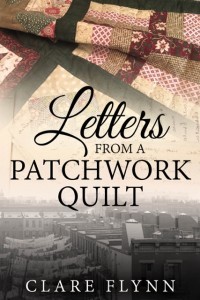 Obviously places change over time – my novel Letters from a Patchwork Quilt is partly set in the industrial town of Middlesbrough in northern England. The part of the town where my characters lived was swept away in the 1960s as part of slum clearance. I did visit Middlesbrough – but I heavily relied on studying old photographs of the town in the nineteenth century. I walked along the nearby beaches, mentally removing the offshore wind-farm and concentrating on the dunes, the patterns of coal dust in the sand and the sound of the birds.
Obviously places change over time – my novel Letters from a Patchwork Quilt is partly set in the industrial town of Middlesbrough in northern England. The part of the town where my characters lived was swept away in the 1960s as part of slum clearance. I did visit Middlesbrough – but I heavily relied on studying old photographs of the town in the nineteenth century. I walked along the nearby beaches, mentally removing the offshore wind-farm and concentrating on the dunes, the patterns of coal dust in the sand and the sound of the birds.
In order to make my setting of a tea plantation in pre-Independence India come alive in Kurinji Flowers, I went to stay in a 1930s tea planter’s bungalow in the middle of nowhere – about 20km from the nearest town. The nearby tea factory was still using the same equipment (including wood-fired furnaces) that had been used by the British in the first half of the last century. I walked the same paths my main character would have walked, photographing and sketching the flora and fauna, experiencing how the place looked, smelled and sounded. I visited what had been the old British colonial club and I hung out in the local market watching the spice sellers, the fabric salesmen and the tailors at work.
3. Watch your language – especially in dialogue
One of the biggest turnoffs for me in some historic fiction is when the author, in an attempt at historical authenticity, peppers the dialogue with “prithee my liege”, thees and thous, and other such expressions in an attempt at historical authenticity. The problem is that, while they may have been widely used in the period in question, they jar horribly to the modern reader and as such create a barrier between reader and characters.
My preference is to use words that would have been used at the time but that still sound natural now, avoid anachronisms and omit any now obsolete ‘curlicues’ of speech such as hither and whither goest thou. After all, people at the time would have found those words completely natural and would not have hesitated over them, whereas we can find them distracting. The author’s challenge is to make the reader feel present in the action not in a library!
But avoiding anachronisms can in itself cause further problems – a lot of very modern-sounding words are in fact quite ancient. My rule of thumb is that if my beta readers, editor, or proof reader point them out as sounding too modern I try to find an alternative – even when they are accurate to the period. It’s all about keeping credibility and a sense of authenticity.
There’s a YouTube video that points out all the speech anachronisms in Downton Abbey (such as get shafted, when push comes to shove and I’ll contact her.). While they may be anachronistic I doubt that many viewers would have noticed some of them.
4. Avoid anachronisms of behaviour as well as of speech and historical fact
Another trap to avoid is having your nineteenth century characters behave in the in the way they would behave today. I’ve just read an otherwise very enjoyable book where I struggled to believe in the female protagonist’s feisty 21st century reaction to her unexpected out-of-wedlock pregnancy at age eighteen in 19th century Mid-West America. Being a single mum in an affluent and respectable family in a small town would have been a very different proposition to making such a choice today and it jarred with me how lightly the heroine took it.
In order to understand the attitudes to sexual behaviour and morality in early 20th century Britain I read some contemporary sex manuals. In fact my bookshelves groan with all sorts of odd titles for research purposes such as The Marriage Manual – a Practical Guide to Sex and Marriage (1936), The Complete Indian Housekeeper and Cook (1904) and Bradshaw’s Railway Handbook (1863).
5. Last but most important – tell a great story!
Writing historical fiction is about telling a story that readers want to read – otherwise you’d be better to write a history book. The most fundamental requirement regardless of the genre you write in is to tell a good tale that will keep your readers hooked to the end – especially if they end up staying up all night to finish it!
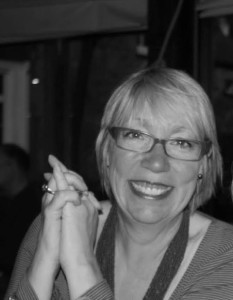 Clare is a graduate of Manchester University, where she read English Language and Literature. After a career in international marketing, working on brands from nappies to tinned tuna and living in Paris, Milan, Brussels and Sydney, she ran her own strategy-consulting business for 18 years in London. She recently moved to Eastbourne on the south coast to focus on her writing and stare out of her kitchen window at the ever-changing sea.
Clare is a graduate of Manchester University, where she read English Language and Literature. After a career in international marketing, working on brands from nappies to tinned tuna and living in Paris, Milan, Brussels and Sydney, she ran her own strategy-consulting business for 18 years in London. She recently moved to Eastbourne on the south coast to focus on her writing and stare out of her kitchen window at the ever-changing sea.
When not writing and reading, Clare loves to splash about with watercolours and grabs any available opportunity to travel – often under the guise of research. You can read mor about Clare and her books here. She can also be found on Twitter and on Facebook.
The post 5 Tips for Writing Historical Fiction by Clare Flynn appeared first on Helena Halme.
April 16, 2016
How To Turn Your Life Into Fiction
Doris Lessing wrote in one of her memoirs that we all re-write history, and that therefore no autobiography can be an accurate account of events
Yet during my MA in Creative writing some 10 years ago, writing the story of your life was somewhat frowned upon, even though one of the most often uttered pieces of advice was to, ‘Write what you know’. I could never marry the two strands of thinking. How are you supposed to write about what you know, but not be allowed to use your life as inspiration?
I did, however, take my MA tutors advice and after graduating wrote two fictional novels, Coffee and Vodka, and The Red King of Helsinki. In both novels I used my life as a mere reference to the time and subject matter of these two stories.
But when, six years ago, I began blogging, I was often asked by my readers why I moved to England from my native Finland. So I started a series of posts, telling the story of my life, of how I met and married my English husband. I imaged that I’d write four or five posts at the most, but when I got to number 25, I realised what I was actually writing was a novel.![Pageflex Persona [document: PRS0000032_00032]](https://i.gr-assets.com/images/S/compressed.photo.goodreads.com/hostedimages/1460887570i/18799977.jpg)
You scream – a novel? Surely what you were writing was an autobiography? Yes, well, it started that way, but being that I am a novelist, new plot lines and characters kept infiltrating the story, and about half way through, I decided I’d give in to my novelist tendencies and carry on writing a fictionalised book of the true story.
So how did I do it – and what is my advice to those wishing to turn their life into a novel?
I have limited myself to 10 points. I could actually write a whole book on the subject, and probably will, but here are the most important points.
1. Where to begin?
Start the novel at a point that is exciting, and has relevance to the main point of the story. “She was born in a small village in West of England” may be the truth, but it may be a tad boring and not very unique. (Everyone is born at some point). Now, of course, if you were born on a raft in the middle of the Pacific, that’s a different matter. The Englishman is a romantic tale, so it starts when Kaisa meets her Englishman at the British Embassy in Helsinki.
2. Inspiration
Use photos, letters (emails) and music for inspiration. I was lucky in that I’d kept all my letters from my husband, and I also had the letters I’d written to him during our long-distance relationship. But you’d be amazed at how many details of our meeting and subsequent long-distance relationship I had forgotten. So I went off and listened to music from the 1980s, watched films and even TV programmes from that time. Slowly all the small details came flooding in; how difficult it was to communicate with each other without mobile phones, or what life was like without the internet (we used libraries and Yellow Pages!).
3. Write Quickly
Don’t worry about letting your pen fly when you start writing. Once you’ve got your memory going, and since you know the plot – and the characters –already, writing the novel can be very quick. If you decide later to change scenes, plot or characters, that’s easy. I found that if I didn’t worry too much about how truthful – or not – the story was, the writing became much more fluid and confident.
4. Time-line
Do shorten the time frame of the story, as this makes the plot more exciting. In real life events often occur slowly, and it’s only when you look back that you see the string of events and their significance to your life. But this is what I think makes turning your life into a piece of fiction so exciting: you can cut time between significant events, and even add a bit of drama by adding new twists and turns to the plot.
5. Characters
Do make your characters complicated and interesting. I’m not saying that your life is filled with boring people, but in order to make a story fly, it needs strong characters. Most people in real life are complicated if you look deep enough, but remember to do that. If you have to write about someone who you dislike in real life, examine why it is that you don’t like them. If they seem one-dimensional to you, think what might be their motivation and there you will find the depth in their character.
6. Who to include?
Don’t include every real person in the novel. To have too many characters in a novel is confusing to the reader. They make the story unnecessarily complicated and jarring. In The Englishman, I combined a few characters to make them stand out more and to increase the pace of the novel. This also allows you to make their roles more significant, and their characters more multi-faceted. This is also helpful if and when people recognise themselves in the novel, and object to being written about. (But really they should never have befriended a novelist, eh?)
7. Dialogue

Don’t use real dialogue. If you’ve ever listened to people on the bus – or even better – recorded a real conversation, you will find that people tend to take a long time to say what they mean. People use of a lot of unnecessary comments, such as ‘hmm’, ‘What I mean is’, ‘Really’. Cut, cut and cut again, is my advice! Make sure dialogue flows and takes the story further. Even if it is important to write good dialogue, it’s even more important what the people say. Personally I avoid long speeches; instead I turn long dialogue into narrative text.
8. Point of View
Think about using a third person narrative instead or 1st person. When I wrote The Englishman blog posts, I did use first person, but later when I began editing the novel, I decided to change the whole story into third person. This was advice given to me by one of my early readers, and I am eternally grateful for her comments. When you use your own life as a plot, the novel will seem too personal, and too much like an autobiography, with a 1st person narrative.
9. Edit, edit and edit again
I’m a firm believer in the editing process. I’ve lost count of how many versions of The Englishman there were. What I didn’t change, however, was the core of the novel; the true love story between an English naval officer and a Finnish student, and the obstacles they had to face in order to sustain their long-distance relationship.
10. Permission to publish
Do get permission to publish from the significant person – or persons – in your story, especially if they can be easily recognised. (And you care about what they think). When I was writing my blog posts, I’d always let my husband (the Englishman) read them before I pressed ‘publish’. Of course if you are writing in the traditional way, and not a blogging the story, it’s easier. When you’re done, you can give the person the manuscript and leave the country for a few days. This maybe the scariest thing you’ll ever do as an author, but being upfront about sharing a ‘true’ story with the world is so much easier than having to deal with it after the book is out. As far as the purely legal position goes, if you can call the work fiction, do so, and cover yourself in by printing a clause in the novel that all persons and places are fictional.
 Celebrating the publication of The Finnish Girl with a glass of bubbly.
Celebrating the publication of The Finnish Girl with a glass of bubbly.Many of those who read and loved The Englishman asked me if I’d write a sequel. I resisted the urge to do this for three years. Partly because I felt I’d told the story already, partly because I didn’t want to share any more of my life. However, while I was resisting writing the book, the story about what it was like to be a foreign Navy Wife in Britain in the 1980s filled the pages of my virtual notebook. And then I found my diary from those early days in the UK. That was the straw that broke the camel’s back; I couldn’t resist it, and began penning down the story of an independent, ambitious, but displaced young woman, newly married to a British Navy Officer. The resulting novel called The Navy Wife is roughly 50% pure fiction and 50% memoir.
My latest novella, The Finnish Girl, is also now out. The book is a prequel to The Englishman, and is based largely on true events. This was an even harder book to write for emotional reasons, but I stuck to the points above and got through it.
This post was first published as part of Indie Author Fringe online conference organised by the Alliance of Independent Authors on the heels of the London Book Fair 2016.
The post How To Turn Your Life Into Fiction appeared first on Helena Halme.
April 15, 2016
The Finnish Girl is out today!
Hurrah, it’s Publication Day at last! The Finnish Girl, a prequel novella to The Englishman is now out and available to buy on Amazon, iBooks, Kobo, Barnes & Noble and all other major e-retailers.
I woke up today to a wonderful 5 * review by a reader, who had forgotten to drink her morning coffee while she read the whole novella in one go. As an author, it doesn’t really get better than this!
Today I am also a guest at Triskele Books blog, where I talk about my books, about where I get my inspiration from, and about my future plans. Hop over and have a read. There are also several other hugely interesting articles on the Triskele site.
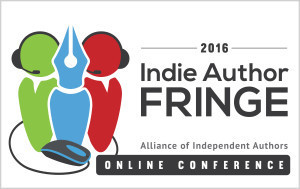 And as if that wasn’t enough, today, on the heels of The London Book Fair, The Alliance of Independent Authors is hosting a 24-hour Indie Author Fringe, where at 8 pm UK time my blog post on How To Turn Your Life Into Fiction (And Stay Sane) goes up. I will also be in the Hot Seat there around the same time, answering any questions that arise from my post & generally about self-publishing. So go over and explore the online conference – there will be a host of useful and interesting advice for authors, plus giveaways and competitions. Amongst the prizes is a FREE signed paperback copy of The Englishman, my novel number one in the Nordic romance series!
And as if that wasn’t enough, today, on the heels of The London Book Fair, The Alliance of Independent Authors is hosting a 24-hour Indie Author Fringe, where at 8 pm UK time my blog post on How To Turn Your Life Into Fiction (And Stay Sane) goes up. I will also be in the Hot Seat there around the same time, answering any questions that arise from my post & generally about self-publishing. So go over and explore the online conference – there will be a host of useful and interesting advice for authors, plus giveaways and competitions. Amongst the prizes is a FREE signed paperback copy of The Englishman, my novel number one in the Nordic romance series!
The post The Finnish Girl is out today! appeared first on Helena Halme.
April 11, 2016
The Finnish Girl Freebie – Chapter Two
![Pageflex Persona [document: PRS0000032_00032]](https://i.gr-assets.com/images/S/compressed.photo.goodreads.com/hostedimages/1459960483i/18679596.jpg) It’s Monday and only 4 days till publication day. Whoopee!
It’s Monday and only 4 days till publication day. Whoopee!
Today’s sample is from Chapter Two of The Finnish Girl. If you missed Chapter One, you can read it here. And if you’d like to order this prequel novella to my Nordic romance, The Englishman, you can do that now on all possible channels, including Amazon, Kobo, iBooks and Barnes & Noble.
Now read on …
Chapter Two
Helsinki, Autumn 1974
One day after school, about two months after her parents’ separation, Kaisa went to get her skates from the store at her old home in Espoo, where her father now lived alone. She’d been putting it off, but her class was due to go ice skating the next day and she knew no amount of excuses would get her off the hook with her new strict gym teacher. Besides, Kaisa didn’t want to be the poor kid in class, who needed to borrow a pair of used, stinking skates at the ice rink. Kaisa liked skating and was quite good at it, so there was nothing for it; she would risk speaking to her father again. Luckily, she’d kept a key, and as she got off the bus and walked up the little hill to where the semi-detached, wood-panelled house stood, she saw the large windows were dark. Kaisa breathed a sigh of relief. She’d be able to slip inside, get the key to the store from the hook in the kitchen, walk to the end of the long garden, retrieve her skates and be on her way back to Lauttasaari in no time.
As she got closer to the house, Kaisa remembered the last time she’d seen her father. It had been early summer, the beginning of May. She’d just turned fourteen and her sister Sirkka was sixteen. Kaisa had been doing homework in her room when she heard her father calling their names. Their bedrooms stood side by side and opened off the oblong living room with its bright red carpet, which her father had promised to replace before they moved in but never had. When Kaisa opened her door, she was faced by Sirkka rolling her eyes at her. By then, Sirkka was living with her boyfriend in the centre of Helsinki most of the time, and was only at home by chance that evening.
‘Sit down girls,’ their father had said. He was sitting opposite the sofa, in one of the large comfy chairs, while their mother, her head bent down, was sitting in the other. A large man, with blue eyes and wispy light-brown hair, that evening their father’s face was drawn and his eyes had huge dark shadows under them.
‘Your mother has decided to leave me for the second time in our marriage,’ he’d said, not looking at either his wife, or his daughters. ‘And I suppose you two will choose to live with her again.’ At that point her father had lifted his eyes at Kaisa, pleading with her. But Kaisa had moved her gaze away and glanced sideways at her sister, who shifted on the sofa and sighed. She knew Sirkka thought their mother ‘had been crazy’ to come back to Finland after she had left ‘the bastard’, as Sirkka often referred to her father. Sirkka hated their father, because he was always telling her what to do, or what he thought of her friends. They didn’t agree on anything.
The first separation hadn’t surprised Kaisa either. The fights and rows started in Stockholm shortly after the family moved there. When her father’s two-year posting in the Swedish capital had come to an end, Pirjo and the girls had stayed in Stockholm while he went back to Finland alone. Both daughters had been glad to stay put. They’d learned to speak Swedish, and loved the city, with its bustling, international vibe. Pirjo rented a beautiful apartment near the Natural History Museum, with views over woodland, and only a bus ride away from Kaisa’s new school and the lovely Mr Sorenson. Still, Kaisa was close to her father, and had missed him in Sweden, although she’d never told her mother or Sirkka this.
Coming back to Finland had been like taking a step back to a poorer, more inward-looking society. Neither Sirkka nor Kaisa had wanted to move to Turku, nor Helsinki a year later, let alone to the unfashionable suburb of Espoo, but they’d had no choice in the matter. Before the move, Sirkka had told her mother she was making a mistake, and back in Finland she’d barely spoken to her father, nor, towards the end, spent much time in the semi-detached house with the red carpet.
Now, as Kaisa slowed her pace, putting off going inside her old home, she shuddered remembering that awful day when her father had sat with his head bent, quiet for a long time. Kaisa had been afraid he would cry, but after the longest few minutes of her life, he’d given her a steady look, and said: ‘OK, off you go with your mother. Good luck!’ The last comment was delivered with a dry, sarcastic laugh. He’d then got up, put on his grey, padded coat and left the house.
When Kaisa opened the door to the house, a familiar, musty smell hit her. She’d forgotten that scent, which Sirkka claimed was mould. She said the three-bedroom, single-storey building was constantly damp and cold, because it had been built on a downward slope, with the red-carpeted lounge abutting the waterlogged garden. Their father had dismissed Sirkka’s claims as ‘pure nonsense’, but now, faced with the familiar smell, Kaisa wondered if her sister had been right.
Kaisa closed the door behind her, and stepped inside the dark hall. The narrow, galley kitchen was right in front of her. She took a sharp intake of breath when she saw a large figure slumped at the table at the far end, in front of the window overlooking the garden. Her father turned towards Kaisa, and lifted his chin in a casual greeting, as if seeing her use her own key to come inside the house was an everyday occurrence.
When Kaisa got closer she saw her father had a glass and a half-empty bottle of Koskenkorva in front of him. He didn’t seem too drunk yet, so Kaisa settled herself opposite him.
‘I need to get something from the garden shed,’ Kaisa said. Her voice was small, and she was struggling to find enough air to fill her lungs.
Her father lifted his eyes to Kaisa and said, ‘Drink?’
‘No, thank you.’ Had her father forgotten she was only fourteen?
He looked down at his glass, lifted it to his lips and drained the contents in one go. He poured another glassful and said, ‘No, I suppose your prissy mother has told you not to drink good old Finnish vodka?’
Kaisa’s heart started to pound hard in her chest. She didn’t dare reply.
‘How is the fucking bitch?’ Her father was now staring hard at Kaisa. His eyes were red-rimmed, and he had the dark shadows of a stubble on his chin.
‘Look, I just want to get my skates, and …’
‘Yes, you want, all of you bloody women just want, want, want stuff all the time.’
Kaisa looked at her father, and suddenly, instead of fear, which his drunkenness usually provoked in her, she felt a surge of anger. It wasn’t her fault that that her parents weren’t able to patch things up again in Finland.
‘It’s not my fault you are impossible to live with.’
She’d uttered the words before she fully realised they’d left her mouth. This was what her mother had said to her over and over during the long months they’d all lived together in Espoo. Kaisa could only agree; her father’s domineering behaviour towards, not only their mother, but also Sirkka, and his constant drinking, weren’t endearing him to anyone.
Kaisa’s words had a terrible effect on her father.
‘What did you say?’ he boomed, getting up from his seat. His eyes were dark and his bulk towered above her. With horror, Kaisa saw him lift his hand as if to slap her, and thought that she should duck. But she couldn’t move a muscle. His hand stopped a few millimetres from her face. For what seemed like an eternity, they stayed that way, her father with his hand close to her face, and Kaisa staring at him. She felt the tears running down her face before she realised she was crying, and angrily wiped them away with the back of her hand. Her gesture seemed to wake her father from the trance, and he slumped heavily onto the chair. Kaisa stood up, ran out of the house, and down the hill towards the bus stop.
The post The Finnish Girl Freebie – Chapter Two appeared first on Helena Halme.


